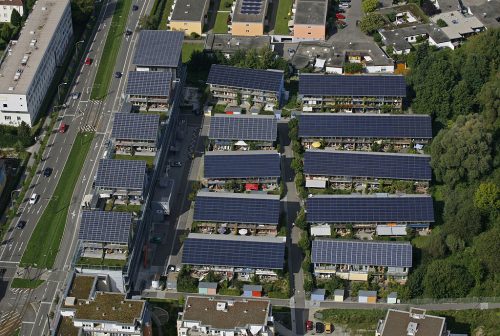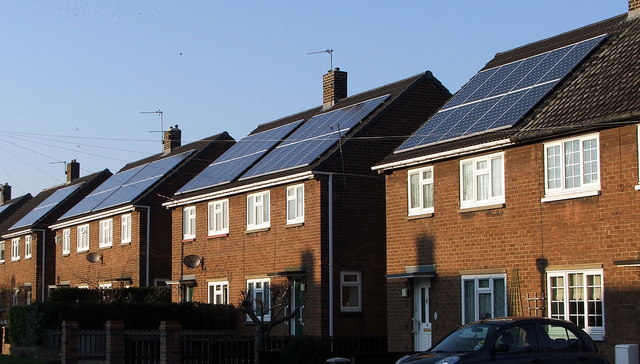Article, Publication
Investigating consumer appetite for peer-to-peer energy trading
by Alexandra Schneiders and Michael Fell (UCL Energy Institute)
Imagine you were given a choice to buy energy directly from other consumers producing their own energy with, for instance, solar panels on their rooftops. Energy bought this way would be slightly cheaper than that what you get from your usual energy supplier. This, in a nutshell, is the idea behind peer-to-peer (P2P) energy trading.
P2P trials are being rolled out across the globe, as the number of consumers producing their own energy (thanks to cheaper renewable energy technologies) is rising. In several of these trials, technologies such as blockchain are being used to facilitate the peer-to-peer financial transactions between participating consumers. The use of this technology has evoked a series of questions from policymakers, due to for instance the close links between blockchain and virtual currencies such as Bitcoin.

Attribution: Andrewglaser at English Wikipedia
Our survey
In November 2018, we conducted a survey of around 2,000 UK-based energy consumers, investigating how consumer demand for such P2P schemes varies according to how the consumer proposition is designed and communicated. We asked people about their preferences when it comes to the proportion of their energy demand met by a P2P energy trading scheme, as well as the locality of the P2P network, and entity in charge of running the network.
Responses indicated that the most preferred option was a higher proportion of their energy demand (out of a choice of 25/50/75%) to be met by other consumers, and at the city/region level (as opposed to national or neighbourhood level). The local council is the preferred entity to run the network, followed by the energy supplier, community energy organisation and social media company.
The survey also investigated consumers’ perceptions of blockchain-specific characteristics. Without directly naming the technology, questions referred to key aspects most mentioned in the promotional language of blockchain energy businesses; such as the technology’s unchangeability (i.e. immutability), anonymity, transparency and decentralisation. Anonymity was slightly more attractive to respondents than the other three characteristics. Interestingly, once the technology was named in the final question, and its association with the virtual currency Bitcoin highlighted, there was a substantial decrease in intended uptake of the offer.
How to interpret the results
The survey results provide several interesting considerations, particularly for policymakers and businesses.
Respondents were least attracted by the social media company running the P2P network. They also rated anonymity as being the most attractive characteristic of the technology underlying the network.
An explanation for these results could be the media attention at the time of the survey on the Cambridge Analytica story. Negative stories around virtual currencies such as Bitcoin are also likely to have had a negative impact on the uptake rate of the scheme. It can also be concluded here that consumers seem to be more concerned about the impact of the technology on their wellbeing (i.e. anonymity) than the technical aspects of the technology.
When it comes to the preferred locality of the peer-to-peer network, respondents seemed to prefer a “middle way” option (city/region), as they might not find the neighbourhood option to be feasible in practice. It is true that in some cases there might not be enough consumers in the same neighbourhood producing energy to meet one’s energy demand. However, at this early stage of grid decentralisation, the same could be said of the city/region level. A safer option to guarantee enough production of energy in a P2P network is the national level.
Ironically, the most suitable entity to run (or at least coordinate engagement around) a nationwide P2P network could be the social media company. Ultimately, the responsible entity will need to ensure that there is enough supply to meet the demand of consumers on the P2P network, and also include those that are less likely to participate in such new business models (older people, non-early adopters).
Key takeaways
Organisations developing and working with peer-to-peer energy trading schemes should bear in mind the following key takeaways:
- The more of their household electricity consumption consumers can expect to meet through a P2P scheme, the more attractive it may be.
- Getting local authorities involved in P2P trading, whether in directly running them or acting in an endorsing or overseeing role, could help increase overall uptake.
- P2P schemes where the messaging places an emphasis on anonymity, and which do not mention the fact that blockchain is the technology behind Bitcoin, are likely to be most popular.
These are some of the main conclusions from our survey study. For more information, read the full study here: https://www.mdpi.com/1996-1073/12/20/3913. In particular, take a look at the Discussion section for a range of questions and challenges that the study illuminated for us. For any questions on findings, please contact Michael Fell (michael.fell@ucl.ac.uk) or Alexandra Schneiders (a.schneiders@ucl.ac.uk).
The UCL Energy Institute’s PACE Group have also been developing the peer-to-peer energy trading board game Watts the Deal? and have also published a Nature Energy comment piece on the boardgame.
Play the game online at the website or print your own copy!
Read about the development of the game on the Centre for Research into Energy Demand Solutions website.
The survey was funded by the EPSRC grant PETRAS Internet of Things (IoT) Research Hub under the project The Internet of Energy Things (‘P2P-IoET’).
Watts the Deal? is developed by Michael Fell, Alexandra Schneiders, Anna Gorbatcheva, David Shipworth and Charlotte Johnson. Primary funding was from the EPSRC grant PETRAS P2P-IoET. Additional funding was received through the UKRI Centre for Research into Energy Demand Solutions and the UCL Bartlett Innovation Fund.
Header image: Photo © Christine Westerback (cc-by-sa/2.0)

